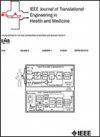CSCI患者便携式膈肌效率监测仪的可行性分析
IF 4.4
3区 医学
Q2 ENGINEERING, BIOMEDICAL
IEEE Journal of Translational Engineering in Health and Medicine-Jtehm
Pub Date : 2025-03-28
DOI:10.1109/JTEHM.2025.3574553
引用次数: 0
摘要
目的:本研究评估一种无创系统监测颈脊髓损伤(CSCI)患者膈肌效率的可行性。方法:开发了两个版本的便携式硬件系统,分别使用阻抗肺成像(IP)测量潮气量(TV)和表面肌电图(sEMG)评估膈电活动(EAdi)。版本1用于确定最佳电极位置,而版本2将这些传感器系统集成到一个紧凑的便携式设计中。对8名健康男性受试者的数据进行分析,以评估TV与呼吸速率(RR)预测的相关性和准确性,以及表面肌电信号与最大吸气压(MIP)的相关性。结果:对于IP,测量胸骨上段和锁骨中线(MCL)之间的第4肋间(IC)空间与真实潮汐量的相关性最高。在表面肌电图中,胸骨中部和第六IC间隙之间的测量显示与MIP的相关性最强。集成版本2硬件在功耗为2.17 mW的情况下同时实现IP和sEMG测量。讨论/结论:所提出的系统和所提出的结果可能为连续监测膈肌效率提供一种实用、经济的解决方案,从而使CSCI患者的家庭呼吸护理成为可能。临床和转化影响声明-这项工作提出了建立一个可穿戴系统的可行性,该系统可以不引人注目地监测膈肌效率,从而为CSCI患者提供无创、经济高效的家庭呼吸护理,促进早期干预和改善长期健康结果。本研究属于美国国立卫生研究院临床光谱的早期/临床前研究类别。本文章由计算机程序翻译,如有差异,请以英文原文为准。
Feasibility Analysis of a Portable Diaphragmatic Efficiency Monitor for CSCI Patients
Objective: This study evaluates the feasibility of a noninvasive system for monitoring diaphragmatic efficiency in people with cervical spinal cord injury (CSCI). Methods: Two versions of a portable hardware system were developed using impedance pneumography (IP) to measure tidal volume (TV) and surface electromyography (sEMG) to assess diaphragm electrical activity (EAdi). Version 1 was used to determine optimal electrode positions, while Version 2 integrated these sensor systems into a compact, portable design. Data from eight healthy male participants were analyzed to assess the correlation and accuracy of TV and respiration rate (RR) prediction using IP and the correlation between sEMG signals and maximum inspiratory pressure (MIP). Results: For IP, measurements between the upper sternum and the midclavicular line (MCL) at the 4th intercostal (IC) space showed the highest correlation with true tidal volume. For sEMG, measurements between the mid-sternum and the 6th IC space demonstrated the strongest correlation with MIP. The integrated version 2 hardware demonstrates simultaneous IP and sEMG measurement while dissipating 2.17 mW. Discussion/Conclusion: The proposed system and the results presented may lead to a practical, cost-effective solution for continuous diaphragmatic efficiency monitoring, and thus enabling home-based respiratory care of CSCI patients. Clinical and Translational Impact Statement– This work presents the feasibility of building a wearable system that can unobtrusively monitor diaphragmatic efficiency, and thus enabling noninvasive, cost-effective, and home-based respiratory care for CSCI patients, facilitating early intervention and improved long-term health outcomes. This study is categorized under the early/pre-clinical research category of the NIH Clinical spectrum.
求助全文
通过发布文献求助,成功后即可免费获取论文全文。
去求助
来源期刊

IEEE Journal of Translational Engineering in Health and Medicine-Jtehm
Engineering-Biomedical Engineering
CiteScore
7.40
自引率
2.90%
发文量
65
审稿时长
27 weeks
期刊介绍:
The IEEE Journal of Translational Engineering in Health and Medicine is an open access product that bridges the engineering and clinical worlds, focusing on detailed descriptions of advanced technical solutions to a clinical need along with clinical results and healthcare relevance. The journal provides a platform for state-of-the-art technology directions in the interdisciplinary field of biomedical engineering, embracing engineering, life sciences and medicine. A unique aspect of the journal is its ability to foster a collaboration between physicians and engineers for presenting broad and compelling real world technological and engineering solutions that can be implemented in the interest of improving quality of patient care and treatment outcomes, thereby reducing costs and improving efficiency. The journal provides an active forum for clinical research and relevant state-of the-art technology for members of all the IEEE societies that have an interest in biomedical engineering as well as reaching out directly to physicians and the medical community through the American Medical Association (AMA) and other clinical societies. The scope of the journal includes, but is not limited, to topics on: Medical devices, healthcare delivery systems, global healthcare initiatives, and ICT based services; Technological relevance to healthcare cost reduction; Technology affecting healthcare management, decision-making, and policy; Advanced technical work that is applied to solving specific clinical needs.
 求助内容:
求助内容: 应助结果提醒方式:
应助结果提醒方式:


